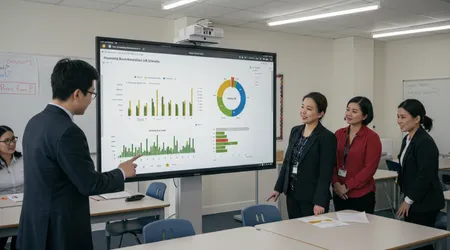Financial Benchmarking Tool Launches for UK Schools

Financial benchmarking has become a cornerstone for UK schools striving to optimise resources in 2025.
The newly launched Financial Benchmarking and Insights Tool (FBIT), introduced by the Department for Education (DfE), replaces outdated platforms like the Schools Financial Benchmarking website and View My Financial Insights.
This innovative tool equips school leaders with data-driven insights to enhance financial efficiency, offering a user-friendly interface and robust analytics.
Why should schools embrace this change?
It’s a game-changer for sustainable budgeting in an era of tightening education funds.
This article explores how FBIT transforms financial management, its practical applications, and what it means for the future of school resource planning.
The FBIT arrives at a critical juncture. UK schools face mounting pressures from rising operational costs and constrained budgets.
With the DfE reporting that 90% of schools engaged in user testing for FBIT, the tool reflects real-world needs.
It merges the best elements of its predecessors, providing historic spending trends and peer comparisons. School leaders can now make informed decisions, ensuring every pound stretches further.
From governors to business managers, FBIT empowers stakeholders to align financial strategies with educational goals, fostering resilience in a challenging economic landscape.
Let’s dive into how this tool reshapes school finance.
What Is the Financial Benchmarking and Insights Tool?
The FBIT is a dynamic platform designed to simplify financial benchmarking for UK schools.
Launched in autumn 2024, it consolidates data from local authority-maintained schools and academies, offering insights into spending patterns.
Unlike its predecessors, FBIT includes three years of historic data, enabling trend analysis.
School leaders can compare their budgets against similar institutions, identifying areas for cost savings or investment.
The DfE’s focus on user feedback ensures the tool is intuitive, addressing practical needs.
Accessibility sets FBIT apart. Anyone involved in school resource management headteachers, governors, or finance officers can use it.
The platform’s financial benchmarking features allow users to input data and receive tailored insights.
For example, a primary school in Manchester could compare its per-pupil spending on staff to a similar school in Leeds, spotting inefficiencies.
This transparency fosters accountability, helping schools justify budgets to stakeholders. The tool’s launch marks a shift towards proactive financial planning.
++ Best Banks in the UK for Savings Accounts in 2025
Moreover, FBIT integrates tools like the Integrated Curriculum and Financial Planning (ICFP) module.
This allows schools to align curriculum delivery with budgets, ensuring educational quality doesn’t suffer.
Imagine a school juggling limited funds: FBIT’s ICFP tool helps balance teacher hours with class sizes, optimising resources.
By replacing clunky legacy systems, FBIT streamlines processes, saving time and reducing errors. It’s a modern solution for modern challenges.

Why Financial Benchmarking Matters in 2025
Budget constraints are tightening, making financial benchmarking essential for UK schools.
Rising energy costs and staff salaries strain resources, with the DfE noting a 4.7% increase in school expenditure from 2023 to 2024.
FBIT helps schools navigate this by offering comparative data, highlighting where savings are possible.
For instance, a secondary school might discover it overspends on utilities compared to peers, prompting a switch to energy-efficient systems.
Also read: UK Salary Guide: How Much Do Different Jobs Pay?
Beyond cost-cutting, financial benchmarking drives strategic planning. Schools can identify best practices from high-performing peers, adopting innovative approaches.
A rural school, for example, might learn from an urban counterpart’s bulk purchasing strategy, reducing supply costs.
FBIT’s data empowers leaders to make evidence-based decisions, aligning spending with student outcomes.
This isn’t just about survival it’s about thriving in a competitive education landscape.
The tool also fosters collaboration. By sharing financial benchmarking data, schools can form partnerships, pooling resources for shared services like IT or catering.
This collective approach maximises value, especially for smaller institutions. FBIT’s launch signals a cultural shift: schools are no longer isolated but part of a data-driven ecosystem.
Embracing this mindset ensures long-term financial health and educational excellence.
Read more: FCA Targets Financial Crime: New Initiatives for 2025/26
Practical Applications of FBIT for School Leaders
FBIT’s financial benchmarking capabilities offer practical tools for everyday challenges. Governors can use it to scrutinise budgets, ensuring funds align with strategic goals.
For example, a school aiming to boost literacy might redirect savings from administrative costs to reading programmes.
The tool’s clear visuals make complex data accessible, even for non-finance experts, fostering inclusive decision-making.
Finance officers benefit from FBIT’s efficiency. The platform automates data entry, reducing manual errors. A business manager in Birmingham could upload 2024 expenditure and instantly see how it stacks up against regional averages.
This saves hours previously spent on spreadsheets. FBIT’s financial benchmarking also supports compliance, helping schools meet DfE reporting requirements with ease.
It’s a lifeline for busy professionals.
Headteachers, meanwhile, can leverage FBIT to plan long-term. By analysing trends, they can forecast future needs, like hiring additional staff or upgrading facilities.
Consider a school anticipating enrollment growth: FBIT’s data helps budget for new classrooms without compromising quality.
The tool’s versatility ensures every stakeholder finds value, making financial benchmarking a cornerstone of effective leadership.
FBIT in Action: A Case Study
| Metric | School A (Actual) | Peer Average | Potential Savings |
|---|---|---|---|
| Per-pupil staff spending | £4,500 | £4,200 | £300 per pupil |
| Energy costs | £50,000 | £40,000 | £10,000 annually |
| Administrative supplies | £15,000 | £12,000 | £3,000 annually |
This table illustrates how a fictional School A used FBIT to identify savings. By comparing its spending to peers, it uncovered inefficiencies, redirecting funds to student services.
Challenges and Opportunities with FBIT
Adopting FBIT isn’t without hurdles. Some schools, especially smaller ones, may lack the expertise to interpret financial benchmarking data.
The DfE addresses this with webinars and guides, but training remains critical. Without support, rural schools risk falling behind urban counterparts with more resources.
Investing in staff development is essential to maximise FBIT’s potential.
Yet, the opportunities outweigh the challenges. FBIT’s data-driven approach levels the playing field, giving all schools access to financial benchmarking insights.
For instance, a struggling academy could emulate a high-performing trust’s budget model, improving outcomes.
The tool also encourages transparency, building trust with parents and regulators. Schools that embrace FBIT position themselves as forward-thinking, ready for future uncertainties.
Looking ahead, FBIT could evolve further. Integrating AI to predict spending trends or offering real-time collaboration features would enhance its value.
Schools must stay engaged with DfE updates to fully capitalise on these advancements.
By overcoming initial barriers, they unlock a wealth of possibilities, making financial benchmarking a catalyst for transformation.
The Future of School Financial Management

What does the future hold for UK school finances? FBIT is a stepping stone towards a data-centric approach.
As budgets tighten, financial benchmarking will be non-negotiable. Schools that master FBIT’s tools will lead the way, setting benchmarks for others.
Imagine a school as a ship navigating stormy seas: FBIT is the compass, guiding it to safer waters with precision.
Collaboration will define the next phase. Schools could form regional networks, sharing financial benchmarking insights to negotiate better supplier deals.
The DfE’s commitment to updating FBIT ensures it remains relevant, with new features like enhanced ICFP tools on the horizon.
This adaptability is crucial in a fast-changing economic climate, where agility saves resources.
Ultimately, FBIT empowers schools to prioritise students. By optimising budgets, leaders can invest in teaching, technology, and well-being programmes.
A school in Bristol, for example, used FBIT to reallocate funds, launching a mental health initiative that boosted attendance.
These stories highlight FBIT’s impact, proving financial benchmarking isn’t just about numbers it’s about building brighter futures.
Conclusion: Seizing the Power of Financial Benchmarking
The Financial Benchmarking and Insights Tool marks a new era for UK schools. By replacing outdated systems, it offers clarity, efficiency, and opportunity.
School leaders now have the tools to navigate financial challenges with confidence, ensuring every decision maximises student benefit.
From governors to headteachers, FBIT unites stakeholders in a shared mission: sustainable, impactful education.
Embracing financial benchmarking isn’t optional it’s essential. Schools that leverage FBIT will not only survive but excel, setting standards for others.
The DfE’s investment in this tool reflects a commitment to empowering educators, and the results are already evident.
As budgets evolve, FBIT will remain a trusted ally, guiding schools towards financial resilience. Take the leap today: your students deserve nothing less.
Frequently Asked Questions
What is the Financial Benchmarking and Insights Tool (FBIT)?
FBIT is a DfE platform launched in 2024, replacing older tools to help schools compare budgets and optimise resources.
Who can use FBIT?
Anyone involved in school resource management, including headteachers, governors, and finance officers, can access FBIT’s financial benchmarking features.
How does FBIT improve financial planning?
It provides historic data, peer comparisons, and ICFP tools, enabling schools to make evidence-based decisions and save costs.
Is training required to use FBIT?
While user-friendly, smaller schools may need DfE webinars or guides to fully leverage financial benchmarking insights.
Where can I access FBIT?
Visit the DfE’s School Resource Management page or the FBIT portal directly to start exploring its features.
